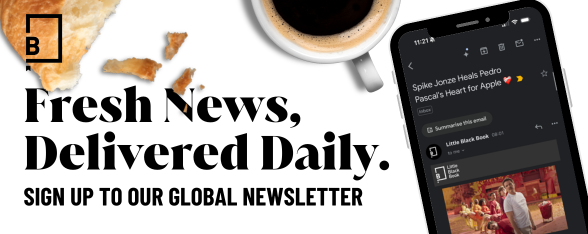
From Craftsperson to Leader: The Journey to Creative Directorship

The path from creative execution to creative leadership is a significant transition in the advertising world, and often one of the most challenging. While early career success is built on crafting ideas, the move into a creative director role requires a change in perspective, responsibility, and skillset.
“The leap to creative director isn’t just a title change; it's a mindset shift,” Mike Herman, VP creative director at Mythic in North Carolina, told LBB. “You move from just making the work to elevating it, creating the environment where great work happens. That takes a new set of skills. Guiding instead of executing. Listening as much as talking. Knowing when to challenge and when to cheer.”
For many, this change can feel like leaving behind what they love – the making – for a world of mentoring and people management. But Mike sees the beauty in that transition. “Now, as a creative director, I think of myself as a coach. I still love great design and creating, but what really excites me is helping my team bring their ideas to life and push their creativity further.”
That coaching mindset is one shared by Diana Samper, global chief creative officer, McDonalds at tms, based in Chicago. “Your success as a creative director hinges entirely on the team you build and their career growth. Shift your mindset to work for them, providing not only tools but also training and opportunities for their success,” she said.
Diana encourages new creative leaders to make time to know their teams and be active in their development. “Dedicate time to guide them and teach them how to navigate various situations, including difficult conversations. Be disciplined in your commitment to this time.”
But becoming an effective leader isn’t just about mentorship, it’s also about strategic decision making. London-based Rosie Pearmain, head of design at Otherway, said one of the hardest parts of leadership is learning to allocate your attention wisely.
“Stepping into more of a director role, you need to keep a constant eye on your priorities. Which fires to fight, which project needs the most investment of your time. It’s like being an investment banker but with your time: making informed gambles on where to focus.”
One way to prepare, she said, is to watch and learn from those around you. “Figure out … which parts you want to emulate, and which parts you don’t. Once you’ve figured out what you think good leadership is, you have to continually mould your own way of doing it that suits you, and allows you to be authentic.”
Authenticity, empathy, and clear communication are the backbone of effective creative leadership. As Mike put it, “What do I try to pass on? Treat every opportunity, every brief, every critique, every late-night scramble, as a chance to learn. Because being a CD isn’t about having all the answers, it’s about knowing how to help your team find them.”
For Diana, it’s crucial to let up-and-coming creative leaders know to “avoid office politics.”
“These distractions can detract from the work you aim to accomplish. Celebrate the team. Recognise the collective effort rather than just individual contributions. The work we do is influenced by many, not just the originator of the idea.”
And for those wondering how to build real longevity in the role, Diana said, “Continue to be a learner and never stop working on your leadership skills.”
The Skills You’ll Need: Be A Boss, Not a Friend. Don’t Try to Have All the Answers
The transition to creative leadership calls for a broader toolkit that includes managing people and making space for others to thrive.
Kieran Kaye, founder and head of audio at Full English Post in Brooklyn, put it simply: “Personnel and team management is the most critical skill I’ve learned, and am still learning, to develop.”
“I’ve personally always been good at dealing with people, especially clients, but being a leader is a whole different kettle of fish. You have to know when to step back and let creativity blossom but at the same time stand firm to ensure quality and guide the project to stay on brief.”
For Mandy Smith, creative director at BUCK Europe, one of the most important skills is “knowing how to manage a team – and shaping your approach to support the team through each phase.”
“At the start, it’s about setting up the right sandbox: giving just enough structure to guide the work without boxing anyone in,” she said.
“If the brief is too tight, it can kill the energy. Too loose, and the work can lose direction or drift away from what the client actually needs. It’s about creating clear, thoughtful boundaries that give creativity the space to thrive.
“It’s also about listening. When people feel safe to follow their instincts and bring their point of view to the table, that’s when the magic happens. The most interesting work often comes from those unexpected moments or ‘happy accidents’ – and giving your team that space builds confidence.”
DDB Sydney creative partner, Jenny Mak, agreed, adding while “communication is everything,” it’s important to remember that “it’s the listening part that’s critical.”
“You need to know when to ask the right questions, not just give the right answers. You must listen closely to where your team is at, their frustrations, their ideas, their doubts. And sometimes, you need to hear what’s unsaid. This is where empathy and emotional intelligence come in. Understanding where your people are emotionally and mentally is just as important as understanding the work. Sensing when someone’s struggling or when they’re on the verge of a breakthrough can make all the difference.”
She said other skills that are often overlooked are patience and the ability to let go and trust your team – because “you can't do it all yourself, no matter how talented you are.”
“Creative ideas take time. Yes, you need to move quickly in some cases, but you need to know when to step back and give people the space to explore. Sometimes the best work comes from a struggle, and that takes patience – not just with others, but with yourself as well. It’s easy to get frustrated when things aren’t coming together, but if you rush the process, you’ll miss the magic.
Developing a new skillset will take time, and progress won’t be perfect.
One of the biggest mistakes Jenny sees creative leaders make early in their journeys – admitting it’s a mistake “I made early on” – is “thinking you need to have all the answers.”
“As a creative, you’re used to being the one with the solution. But when you step into a leadership role, your job isn’t to have all the answers, it’s to help your team find them. Too often, I’d step in, try to fix things, and unintentionally shut down my team’s own creative problem-solving. It’s a fine line between guiding and taking over, and early on, I tripped over that line more times than I’d like to admit.
“Another common mistake is neglecting your own growth. You get so caught up in managing others, you forget that you still need to be developing yourself. Leadership is an ongoing learning process.”
Kieran added, “this might be controversial but I think it’s a mistake to be a friend as a leader.”
“I’m not saying to be unfriendly or to stay perfectly in lane as a boss; camaraderie is extremely important within any company team. But I’ve become mates with team members in the past – also not saying that’s a terrible thing – and it blurs the lines of leadership making it difficult to truly lead a team. Then when it comes to tough decisions in the company hierarchy, it makes it challenging to put on the ‘boss’ hat and pull rank.
“Team members can lose respect and emotions can become involved, which I’ve learned to try and avoid. It’s not easy distancing yourself personally from the people you work with everyday, but in my opinion, keeping the lines focused is important.”
Mandy added a common mistake relates to “finding the right way to work with a client, especially when you’re not quite seeing eye to eye. It can be easy to get defensive, but often the key is curiosity – asking the right questions to understand where they’re coming from. There’s usually a middle ground; you just need to create the space to find it together.”
Stay Close to the Work While Stepping Back
Stepping into a leadership role doesn’t mean stepping away from creativity, but rather finding a new way to engage with it, often through your people.
Creative director at Australian indie Cocogun, Loz Maneschi, balances “maintaining my own creative instincts while giving space for my team’s ideas to grow” by making sure she’s “always dreaming up ideas on the side.”
“Lewis Clark – a copywriter at Cocogun – and I have an ongoing list of ambitious little projects, some of which led to our Young Lions Film win, which is sending us to Cannes in June. This type of ongoing creative momentum keeps our instincts super sharp for the work we do inside the 9 to 5.
“I think it depends on the team, but in a tight indie like Cocogun, we’ve got to stay in it, tools, trenches and all. Which honestly, brings me so much joy. Getting your hands dirty keeps you credible. I never want to stop refining my craft.”
It’s a sentiment shared by William Campbell, co-owner and director at Scholar, Los Angeles, who said, “My job isn’t to drive every idea, it’s to help steer the ship.”
“I still bring my instincts to the table, but I check them against the needs of the project and the voice of the team. I think of it as creative shepherding,” he said.
“I help guide the work in a direction that excites the client, fulfills the artist, and feels modern and exciting to me. The best projects are the ones where that triangle clicks.”
Getting on the tools is a critical part of his creative process, “not because I don’t trust my team, but because staying close to the craft keeps me grounded. Scholar runs on a blue-collar creative engine. We believe in rolling our sleeves up and pitching in. I still sketch, edit, shoot, and render. Not every day, but on every project, and enough to stay connected. That said, you’ve got to pick your moments. Leadership means knowing when to jump in, and when to step back and let someone else drive.”
For James Segura, creative director at H/L in San Francisco, the transition involved learning to let go, although he added, “we should never abandon what made us fall in love with this craft.”
“I went from being hands-on with every project to becoming the person who sets the tone, clears roadblocks, and keeps the team inspired. I missed the thrill of getting a fresh brief, teaming up with a partner, and diving into the excitement of ‘what could this be?’ Then solving it, selling it, and bringing it to life.
“That craving to stay close to the work made my early days as a CD harder than they needed to be. I thought I had to have all the answers. I’d jump in too quickly, tweak decks late in the game, or rework concepts myself instead of coaching the team through it. Letting go of that instinct and learning to lead through trust was a turning point for me.
“We are still part of the team, just playing a different position. I got here because I was a strong creative, and that still matters. Now it is about finding the balance between what made you successful and what the role demands.
“I ask questions, stay curious, and lean on my team to keep me sharp. That is not just about staying relevant; it is a way to show that I respect and value what they bring to the table.”















